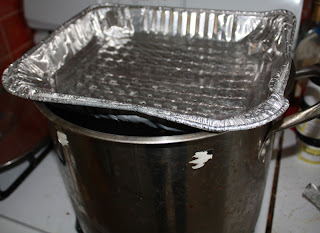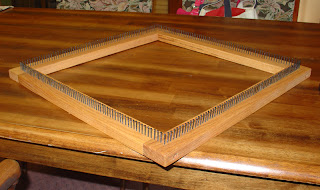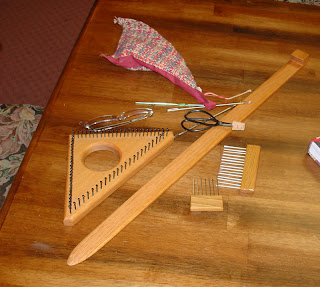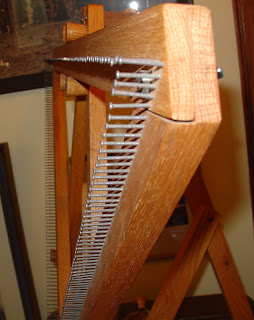I was recently asked to dye some yarn for a young lady to use in knitting. I took the opportunity to try a technique that I had come across on a youtube video. I can't wait to see how the yarn knits up!
First off I made a rack that I am going to refer to as a Striping Rack. I had an old simple loom that John had made for one of the girls and I pulled out all the bent nails. I went to the hardware store and bought some "L" hooks that were 2 1/4" long. I spaced them across the striping rack on two sides. I advise drilling pilot holes and using a pair of pliers to put the hooks in.
Striping Rack in all it's shabby glory.
Here you can see the side of the hooks where you will be wrapping your yarn. I've got plenty of space to fill up for each stripe run.
I could focus better, couldn't I?
To prep the yarn I put it in a large bowl in the sink with tepid water and let it soak for several hours. I put the yarn in before I left to go on errands and I wanted to make sure it would wick up the dye properly. I am sure 1 hour would be long enough normally. I rolled the skein up in a towel and blotted out most of the water before wrapping. I started on one end and I wrapped the yarn around the two opposing hooks 5 times and then moved to the next pair. I did that back and forth until the entire skein was loaded.
Striping rack loaded with wet wool.
To remove the wool groups, I turned the hook to face inward so I could slip that side off. Be sure to turn it back for future use. Next, I used some disposable bags and put each grouping of wool into a separate bag. The wool will come in and out of each bag where it connects to the following stripe group.
Yarn in bags ready for the addition of dye solutions.
I made up squeeze bottles with each color of stripe I wanted to have. I lined the bags up on a protective surface on the counter, (really I forgot to do this and I'm now scrubbing the counter with bleach to get the dye stains off. Learn from my mistakes people!) and squirt your dye into the first bag. Massage the color around so you get all of the yarn saturated. Be generous! I did this batch in black and red stripes so the bags were alternating in color. When I got to the yarn that was sticking up out of the bag, I carefully squirted dye to cover and meet the next color. Oh yeah, do wear gloves. My hands are currently quite colorful due to that oversight.
The dyepot setup I used was very simple. I have an old pot that I filled 1/4 full with water and I took a foil disposable baking pan and poked it with holes. I don't use this pot for any other purpose. Once it has had dye in it, you can no longer use that item for food.
It doesn't have to be pretty! It just has to work!
I turned the stove up until the water came to a good simmer and made plenty of steam. Place your dye bags in the foil pan by grabbing them together all at once by the tops. Make sure the bottom of each bag touches the bottom of the foil pan. You want the steam to come up through the holes and heat the dye solution for proper intake of the color.As you can see, I poked a lot of holes.
I left the setup steaming for an hour, occasionally checking to make sure the water was not boiling dry in the pot. I added very hot tap water if I thought it needed it.
The bags are snugly together in the foil pan.
After the hour I kept checking to make sure that the water in the bags had gone pretty clear. I let the yarn steam for approximately an hour and a half in total. You will see a small amount of water condensing inside the bags. Not to worry! This is completely normal.
When you are ready to rinse, put all of the bags into the sink or rinse basin you plan to use, and empty one at a time. Rinse each bundle thoroughly without combining into one mass.
Then came the frustrating part! I ended up rolling the yarn into a ball and then wrapping around a niddy noddy to get back into a skein. I definitely need to come up with a tying method to keep the tangles down.
Here are the results of three colorways.
From the left the colors I used were Dharma Dyes, Fire Engine Red, Brilliant Yellow and Blazing Orange. The center is True Black and Fire Engine Red. The Right is Periwinkle, and Flamingo Pink with a section left undyed.
As soon as they dry they are off to their owner!




















